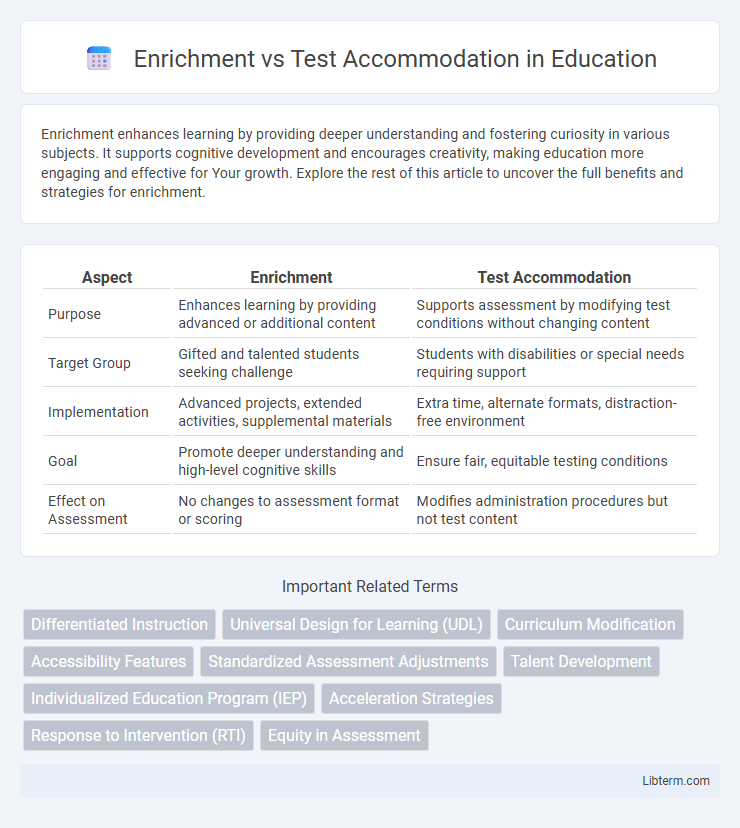Enrichment enhances learning by providing deeper understanding and fostering curiosity in various subjects. It supports cognitive development and encourages creativity, making education more engaging and effective for Your growth. Explore the rest of this article to uncover the full benefits and strategies for enrichment.
Table of Comparison
| Aspect | Enrichment | Test Accommodation |
|---|---|---|
| Purpose | Enhances learning by providing advanced or additional content | Supports assessment by modifying test conditions without changing content |
| Target Group | Gifted and talented students seeking challenge | Students with disabilities or special needs requiring support |
| Implementation | Advanced projects, extended activities, supplemental materials | Extra time, alternate formats, distraction-free environment |
| Goal | Promote deeper understanding and high-level cognitive skills | Ensure fair, equitable testing conditions |
| Effect on Assessment | No changes to assessment format or scoring | Modifies administration procedures but not test content |
Understanding Enrichment and Test Accommodation
Enrichment involves providing students with advanced learning opportunities beyond the standard curriculum to promote deeper understanding and cognitive growth. Test accommodation refers to modifications or adjustments in testing conditions, such as extended time or alternative formats, aimed at ensuring equitable assessment for students with disabilities or specific learning needs. Understanding the distinction highlights enrichment's focus on acceleration and challenge, whereas test accommodation prioritizes fairness and accessibility during evaluations.
Key Differences Between Enrichment and Test Accommodation
Enrichment involves providing advanced learning opportunities beyond the standard curriculum to enhance students' knowledge and skills, while test accommodation modifies the testing environment or format to support students with disabilities without altering the content. Key differences include enrichment's goal to challenge and extend learning versus accommodations aiming to ensure equitable access and accurate assessment of abilities. Enrichment targets academic growth, whereas accommodations focus on removing barriers for fair evaluation.
Goals of Enrichment in Education
Enrichment in education aims to deepen students' understanding by offering advanced, meaningful learning experiences that extend beyond the standard curriculum. It fosters critical thinking, creativity, and problem-solving skills through challenging activities tailored to students' interests and abilities. Enrichment supports intellectual growth and motivation without altering assessment conditions, distinguishing it from test accommodations designed to provide equitable testing environments.
Purpose of Test Accommodation for Students
Test accommodation aims to provide equitable testing conditions for students with disabilities by modifying the test environment or format to reduce barriers without altering the test content or expectations. These accommodations ensure that assessments measure the student's knowledge and skills rather than their disability, supporting accurate evaluation of academic achievement. Unlike enrichment, which focuses on extending learning opportunities, test accommodations specifically target accessibility and fairness during standardized testing.
Types of Enrichment Strategies
Enrichment strategies include curriculum compacting, independent study projects, and real-world problem-solving tasks that enhance student learning beyond standard requirements. These approaches aim to deepen knowledge and skills through differentiated instruction, offering challenges tailored to students' strengths and interests. Test accommodations, by contrast, modify assessment conditions without altering content, whereas enrichment modifies content and learning experiences to foster advanced cognitive development.
Common Test Accommodation Methods
Common test accommodation methods include extended time, alternative test formats, and flexible scheduling, designed to provide equitable assessment conditions for students with disabilities. Enrichment strategies focus on enhancing learning experiences, while test accommodations adapt the testing environment to reduce barriers without altering the test content. These accommodations ensure compliance with legal standards like the ADA and IDEA, promoting fairness in educational assessments.
Identifying Student Needs: Enrichment or Accommodation?
Identifying student needs involves assessing whether learners require enrichment opportunities or test accommodations to optimize their academic performance. Enrichment benefits students who demonstrate advanced skills by providing challenging materials that promote deeper understanding and critical thinking. Test accommodations support students with disabilities or learning differences, ensuring equitable access to assessments through adjustments like extended time or alternate formats.
Impact on Academic Achievement
Enrichment programs enhance academic achievement by providing advanced learning opportunities tailored to gifted students, which promote critical thinking and subject mastery. Test accommodations, such as extended time or alternative formats, support equitable assessment conditions, mitigating the impact of disabilities on test performance. While enrichment fosters long-term academic growth, accommodations ensure fair evaluation of true academic abilities, each playing a distinct role in optimizing student outcomes.
Challenges in Implementation
Implementing enrichment programs often faces challenges such as limited resources, insufficient teacher training, and difficulty in identifying students who would benefit most, leading to inconsistent outcomes. Test accommodations present obstacles including ensuring fairness while maintaining test validity, logistical complexities in standardized testing environments, and resistance from educators unfamiliar with accommodation protocols. Both approaches require careful planning, ongoing professional development, and stakeholder collaboration to address equity and effectiveness in diverse educational settings.
Best Practices for Educators
Enrichment strategies enhance learning by providing advanced materials and challenges that match students' abilities, promoting deeper understanding and engagement. Test accommodations involve modifications such as extended time or alternative formats to ensure equitable assessment for students with disabilities or diverse learning needs. Educators should implement enrichment and accommodations based on individual learner profiles, using data-driven decisions and collaboration with specialists to optimize educational outcomes.
Enrichment Infographic

 libterm.com
libterm.com